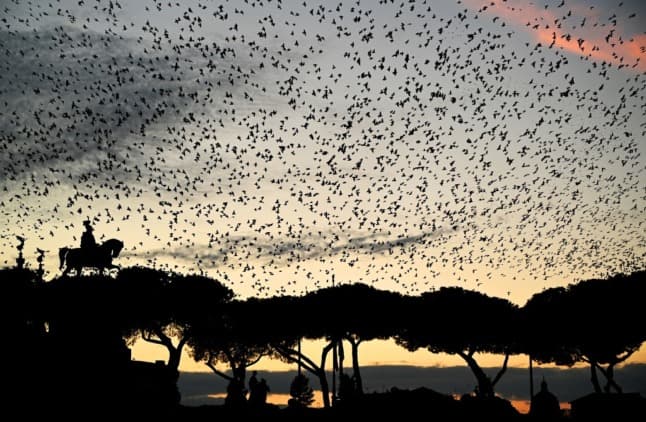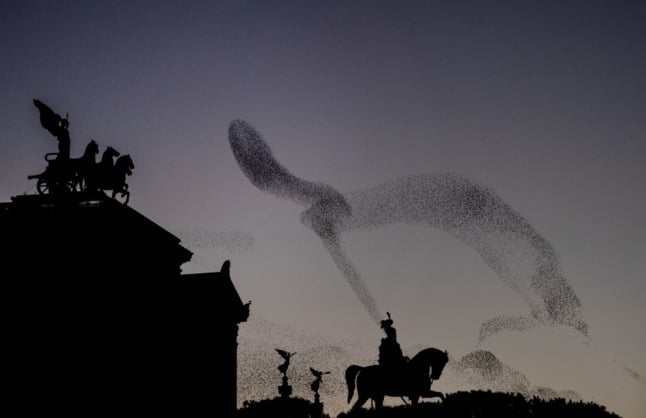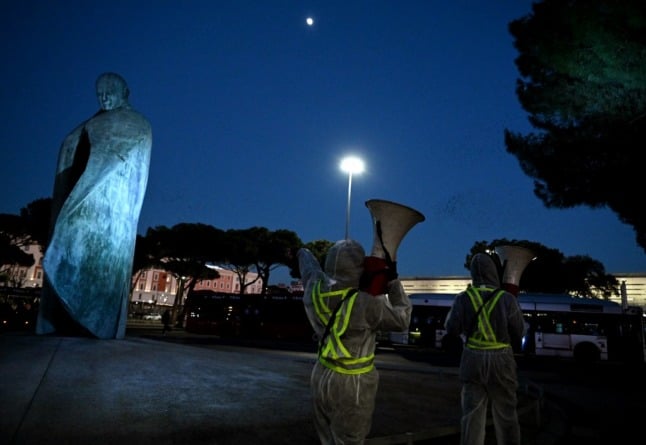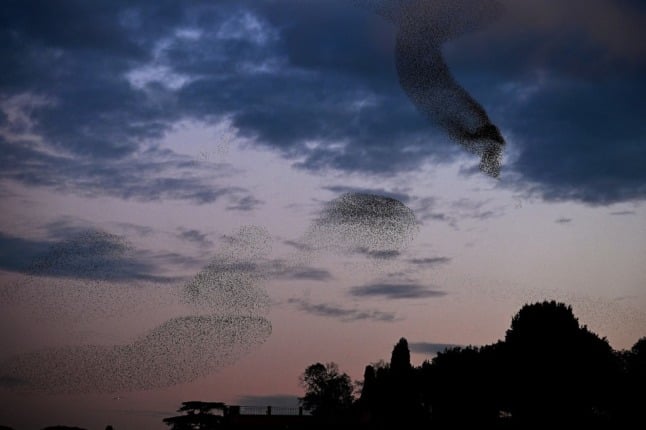IN PICTURES: Magical but messy Rome scares off its starlings

As the sun sets over central Rome, five figures in white overalls move under the trees. They wave speakers emitting a mix of sharp cries, and the birds rise into the air.
Every winter, the skies over Italy's capital are filled with the mesmerising sight of thousands of starlings swooping and diving in unison.
But when they stop to rest on the trees, their droppings coat the pavements and cars below -- prompting the city authorities, every year, to try to scare them away.
"We act on their fear reflex by using their own alarm call," said Marianna Di Santo, clad head-to-toe in white protective clothing and heading towards the birds gathered in trees around Termini central train station.
"It's as if they were warning each other that this is a dangerous place and they should move away," said Di Santo, whose company, Fauna Urbis, is hired by the Rome authorities to disperse the starlings.

Members of the association Fauna Urbis carry out a wintering starlings removal operation on January 14th, 2022 at Piazza dei Cinquecento by the Termini railway station in downtown Rome, as part of the the capital's removal programme, which is coordinated by the department of the environment. (Photo by Vincenzo PINTO / AFP)
Up to one million
Between October and February every year, millions of starlings migrate from northern Europe to Italy in search of warmer temperatures for the winter.
Their synchronised ballets -- murmurations -- over the Eternal City's centuries-old churches, palaces and ruins entrances passers-by.
"I've never seen such a thing in my life. It's spectacular," said Spanish tourist Eva Osuna, taking out her phone to capture the magic.
The glossy dark-feathered birds, which measure up to 20 centimetres each, spend the day feeding in rural areas before heading back into town to sleep, explains ornithologist Francesca Manzia from Italy's League for Bird Protection (LIPU).
"In the city, the temperatures are higher and the light helps them find their way around, and protects them from predators," she told AFP.

Starlings fly over the Altare della Patria monument in Rome. (Photo by Tiziana FABI / AFP)
Warmer temperatures in northern European caused by climate change have shortened the starlings' stay in Italy, but their sheer numbers make them a force to be reckoned with.
Between 500,000 and one million are believed to be in Rome this year, according to one expert.
Naturally "gregarious", according to Manzia, they stick together at night, creating collective dormitories in the trees.
She insisted the starlings "do not carry diseases" but pose problems "because of their droppings, which make the roads slippery and smell very strong".
In their nature
Such is the problem that, even on a clear day, it is not uncommon to see Romans walking along tree-lined streets with umbrellas as protection against the birds.
City authorities use sounds and also lights not to chase the birds out of the city, but to split them up into smaller, more manageable groups.

Members of Fauna Urbis hold speakers, which emit a mix of sharp cries, to encourage the birds to rise into the air. (Photo by Vincenzo PINTO / AFP)
Sounds are "the most simple and effective" way of moving the birds on, said Valentina de Tommaso from Fauna Urbis.
She works two or three times a week near Termini, which -- with its lights and shelter from the wind -- is a "comfortable" place for the birds to rest.
"We play recordings for about 10 minutes, with breaks in between so they do not get used to the noise" -- a tactic that aims to be annoying but harmless, she said.

A murmuration of starlings as night falls over the Ancient Forum in Rome. (Photo by VINCENZO PINTO / AFP)
The piercing noise draws a small crowd, some of them approving, others less so.
"They pose lots of problems. Walking around under flocks of starlings is not really ideal," said Francesco Fusco, a 55-year-old engineer.
"They are magnificent," counters 16-year-old Alessio Reiti, saying he does not understand why they need to be scared away.
"It's in their nature. We are not going to make them wear nappies!" he said, laughing.
Comments
See Also
Every winter, the skies over Italy's capital are filled with the mesmerising sight of thousands of starlings swooping and diving in unison.
But when they stop to rest on the trees, their droppings coat the pavements and cars below -- prompting the city authorities, every year, to try to scare them away.
"We act on their fear reflex by using their own alarm call," said Marianna Di Santo, clad head-to-toe in white protective clothing and heading towards the birds gathered in trees around Termini central train station.
"It's as if they were warning each other that this is a dangerous place and they should move away," said Di Santo, whose company, Fauna Urbis, is hired by the Rome authorities to disperse the starlings.

Up to one million
Between October and February every year, millions of starlings migrate from northern Europe to Italy in search of warmer temperatures for the winter.
Their synchronised ballets -- murmurations -- over the Eternal City's centuries-old churches, palaces and ruins entrances passers-by.
"I've never seen such a thing in my life. It's spectacular," said Spanish tourist Eva Osuna, taking out her phone to capture the magic.
The glossy dark-feathered birds, which measure up to 20 centimetres each, spend the day feeding in rural areas before heading back into town to sleep, explains ornithologist Francesca Manzia from Italy's League for Bird Protection (LIPU).
"In the city, the temperatures are higher and the light helps them find their way around, and protects them from predators," she told AFP.

Warmer temperatures in northern European caused by climate change have shortened the starlings' stay in Italy, but their sheer numbers make them a force to be reckoned with.
Between 500,000 and one million are believed to be in Rome this year, according to one expert.
Naturally "gregarious", according to Manzia, they stick together at night, creating collective dormitories in the trees.
She insisted the starlings "do not carry diseases" but pose problems "because of their droppings, which make the roads slippery and smell very strong".
In their nature
Such is the problem that, even on a clear day, it is not uncommon to see Romans walking along tree-lined streets with umbrellas as protection against the birds.
City authorities use sounds and also lights not to chase the birds out of the city, but to split them up into smaller, more manageable groups.

Sounds are "the most simple and effective" way of moving the birds on, said Valentina de Tommaso from Fauna Urbis.
She works two or three times a week near Termini, which -- with its lights and shelter from the wind -- is a "comfortable" place for the birds to rest.
"We play recordings for about 10 minutes, with breaks in between so they do not get used to the noise" -- a tactic that aims to be annoying but harmless, she said.

The piercing noise draws a small crowd, some of them approving, others less so.
"They pose lots of problems. Walking around under flocks of starlings is not really ideal," said Francesco Fusco, a 55-year-old engineer.
"They are magnificent," counters 16-year-old Alessio Reiti, saying he does not understand why they need to be scared away.
"It's in their nature. We are not going to make them wear nappies!" he said, laughing.
Join the conversation in our comments section below. Share your own views and experience and if you have a question or suggestion for our journalists then email us at [email protected].
Please keep comments civil, constructive and on topic – and make sure to read our terms of use before getting involved.
Please log in here to leave a comment.